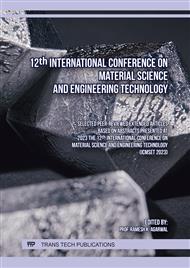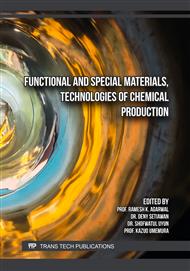[1]
B. J. Tuazon, N. A. v. Custodio, R. B. Basuel, L. A. D. Reyes, and J. R. C. Dizon, "3D Printing Technology and Materials for Automotive Application: A Mini-Review," in Key Engineering Materials, vol. 913 KEM, Trans Tech Publications Ltd, 2022, p.3–16.
DOI: 10.4028/p-26o076
Google Scholar
[2]
G. Yu, M. Song, S. Jiao, X. Jia, and Y. Li, "Flame Retardancy of Thermoplastic Polyurethane Using Phosphorus-containing Flame Retardants," IOP Conf Ser Mater Sci Eng, vol. 585, no. 1, p.012038, Jul. 2019.
DOI: 10.1088/1757-899X/585/1/012038
Google Scholar
[3]
Information on https://omnexus.specialchem.com/selection-guide/thermoplastic-polyurethanes-tpu/key-applications
Google Scholar
[4]
Information on https://omnexus.specialchem.com/selection-guide/thermoplastic-polyurethanes-tpu (accessed Aug. 26, 2022).
Google Scholar
[5]
A. Żur, P. Żur, P. Michalski, and A. Baier, "Preliminary Study on Mechanical Aspects of 3D-Printed PLA-TPU Composites," Materials, vol. 15, no. 7, p.2364, Mar. 2022.
DOI: 10.3390/ma15072364
Google Scholar
[6]
J. R. C. Dizon, A. H. Espera, Q. Chen, and R. C. Advincula, "Mechanical characterization of 3D-printed polymers," Addit Manuf, vol. 20, p.44–67, Mar. 2018.
DOI: 10.1016/j.addma.2017.12.002
Google Scholar
[7]
C. C. L. Gache, B. J. Tuazon, M. T. Espino, R. C. Advincula, J. R. C. Dizon, "3D-Printed Polymeric Spare Parts for Industrial Applications: A State-of-the-Art Review," SciEnggJ, Vol. 15, No. 2, December 2022, pp.128-144, [Online] Available: https://www.researchgate.net/publication/366166922_3D-Printed_Polymeric_Spare_Parts_for_Industrial_Applications_A_State-of-_the-Art_Review
Google Scholar
[8]
M. Vaezi, H. Seitz, and S. Yang, "A review on 3D micro-additive manufacturing technologies," The International Journal of Advanced Manufacturing Technology, vol. 67, no. 5–8, p.1721–1754, Jul. 2013.
DOI: 10.1007/s00170-012-4605-2
Google Scholar
[9]
Information on https://www.hubs.com/knowledge-base/3d-printing/
Google Scholar
[10]
Information on https://3dprinting.com/3dprinters/best-large-scale-fdm-fff-3d-printers-big-enough-to-3d-print-furniture/
Google Scholar
[11]
Information on https://tractus3d.com/materials/tpu/
Google Scholar
[12]
Boubakri, N. Guermazi, K. Elleuch, and H. F. Ayedi, "Study of UV-aging of thermoplastic polyurethane material," Materials Science and Engineering A, vol. 527, no. 7–8, p.1649–1654, Mar. 2010.
DOI: 10.1016/j.msea.2010.01.014
Google Scholar
[13]
Mizera, M. Manas, and P. Stoklasek, "Effect of Temperature Ageing on Injection Molded High-Density Polyethylene Parts Modified by Accelerated Electrons," Materials, vol. 15, no. 3, Feb. 2022.
DOI: 10.3390/ma15030742
Google Scholar
[14]
García-Moreno, M. Á. Caminero, G. P. Rodríguez, and J. J. López-Cela, "Effect of thermal ageing on the impact and flexural damage behaviour of carbon fibre-reinforced epoxy laminates," Polymers (Basel), vol. 11, no. 1, Jan. 2019.
DOI: 10.3390/polym11010080
Google Scholar
[15]
M. Frigione and A. Rodríguez-Prieto, "Can accelerated aging procedures predict the long term behavior of polymers exposed to different environments?," Polymers, vol. 13, no. 16. MDPI AG, Aug. 02, 2021.
DOI: 10.3390/polym13162688
Google Scholar
[16]
Information on https://www.customgasketmfg.com/blog/rubber-gasket-materials/#:~:text=.-,Nitrile%20(Buna-N),%2C%20and%20petroleum-based%20compounds (accessed Aug. 26, 2022).
Google Scholar
[17]
"Standard Test Method for Tensile Properties of Plastics 1".
DOI: 10.1520/D0638-14
Google Scholar
[18]
A. International and files indexed by mero, "Standard Practice for Heat Aging of Plastics Without Load 1."
Google Scholar
[19]
Keystone Compliance, "MIL-STD 883 Temperature Cycling Testing." https://keystonecompliance.com/mil-std-883/temperature-cycling/ (accessed Aug. 26, 2022).
Google Scholar
[20]
Information on https://commons.erau.edu/cgi/viewcontent.cgi?article=1008&context=panasomm
Google Scholar
[21]
Arifvianto, T. N. Iman, B. T. Prayoga, R. Dharmastiti, U. Salim, M. Mahardika, Dr. Suyitno, "Tensile properties of the FFF-processed thermoplastic polyurethane (TPU) elastomer.", March 2021, available:.
DOI: 10.21203/rs.3.rs-299979/v1
Google Scholar
[22]
R. H. Alasfar, S. Ahzi, N. Barth, V. Kochkodan, M. Khraisheh, & M. Koç, "A Review on the Modeling of the Elastic Modulus and Yield Stress of Polymers and Polymer Nanocomposites: Effect of Temperature, Loading Rate and Porosity." Polymers, 14(3), 360., (2022) MDPI AG. Retrieved from
DOI: 10.3390/polym14030360
Google Scholar
[23]
Information on https://insights.globalspec.com/article/7810/how-to-perform-tensile-testing-on-polymers
Google Scholar
[24]
M.L. Di Vona, (2014). "Annealing of Polymer Membranes." Encyclopedia of Membranes. Springer, Berlin, Heidelberg. Jan. 2014
DOI: 10.1007/978-3-642-40872-4_627-1
Google Scholar
[25]
Information on https://www.ptonline.com/articles/materials-thermoplastic-urethanes-why-annealing-makes-a-big-difference
Google Scholar
[26]
Z. Razak et al., "Effects of thermal cycling on physical and tensile properties of injection moulded kenaf/carbon nanotubes/polypropylene hybrid composites," Compos B Eng, vol. 168, p.159–165, Jul. 2019.
DOI: 10.1016/j.compositesb.2018.12.031
Google Scholar



